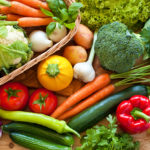Red, White, and Meat All Over
Boneless, skinless chicken cutlets, flank steak, and skinless salmon seem to be common staples for many following a healthy eating plan.
Understandably, they’re easy to find, easy to prepare and are, indeed, healthy options, especially if we’re mindful of sourcing them properly in order to ensure the poultry is pasture raised, the beef is 100% grass fed, and the salmon was wild. But even if you were eating the best of the best, you’d be limiting yourself by only eating lower fat types of protein.
Let’s start with rich, oily fish. Populations that eat fish regularly live longer and have less chronic disease than populations that do not. Those who eat fatty fish from cold northern waters enjoy rich omega-3 fatty acids, which our bodies need for optimum health. Wild salmon, mackerel, herring, sardines and bluefish are all great options.1
How about fattier meats? It doesn’t always have to be the grass-fed beef filet. While that’s certainly a delicious cut, it’s also one of the pricier ones. Yet, many feel apprehensive buying slightly more marbled cuts of beef when the perception is it’s unhealthier or you just don’t know how to cook it properly.
Let’s address the health concern first. Eating a fatty ribeye from a corn-fed cow is a far cry from eating one from a 100% grass fed, humanely raised one. Meat from grass-fed animals has two to four times more omega-3 fatty acids than meat from grain-fed animals. Furthermore, meat from grass-fed ruminants are the richest known source of another type of good fat called “conjugated linoleic acid” (CLA).2
Finally, saturated fat is not actually the demon the media makes it out to be. Not all saturated fatty acids are created equal and that while some contribute to heart disease; others can be very beneficial with specific benefits. Categorizing them all under one umbrella would be the same as pretending a hot dog is as healthy a protein choice as a wild salmon fillet!
Avoid saturated fats that are processed or otherwise not readily available in a natural form like canola and soybean oil, hydrogenated fats like margarine, and any fats that come from a “non-living” source (i.e., manufactured fats such as trans-fats). Say goodbye to Crisco!
The best sources of saturated fats are coconut oil, avocado, grass-fed beef, tallow, and free-range eggs. These foods contain fats that are beneficial to our health and contain the various fats in ratios that are conducive to achieving optimal health.3
Now on to the cooking. Let’s talk meat!
Keep in mind grass-fed animals are inherently leaner than their corn-fed counterparts. Since they weren’t fattened up with grain, they’ll require less time to cook. Even that fatty ribeye from a grass-fed cow is less fatty than a grain-fed one!
I love all kinds of prep, but my favorite way to enjoy a nice steak is to savor the taste of the meat itself, pure and simple. Give one of my favorite recipes for a delectable grass-fed ribeye a try. Serves four, perhaps with leftovers!
REFERENCES
[1] Balanced Living.” Facts About Fish. N.p., n.d. Web. 09 June 2015.
[2] “Health Benefits of Grass-Fed Products.” Eat Wild. N.p., n.d. Web. 09 June 2015.
[3] “The Other Side of Saturated Fats: Health Benefits of a Fat Rich Diet.” The Huffington Post. N.p., n.d. Web. 09 June 2015.






